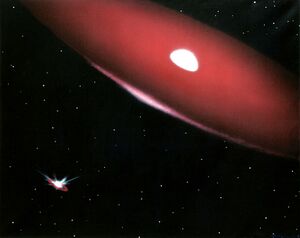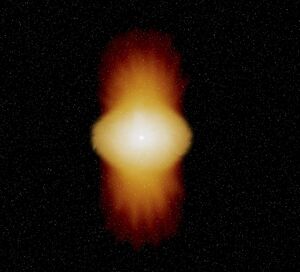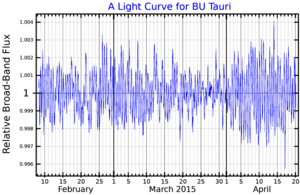بلييوني (نجم)
| بيانات الرصـد الحقبة J2000 اعتدال J2000 | |
|---|---|
| الكوكبة | Taurus |
| الصعود المستقيم | 03س 49د 11.2166ث[1] |
| الميل | 24° 08′ 12.157″[1] |
| القدر الظاهري (V) | 4.77 - 5.50[2] |
| الخـصـائص | |
| النوع الطيفي | B8Vne[3] |
| B-V دليل الألوان | −0.08[4] |
| النوع المتغير | γ Cas[2] |
| علم القياسات الفلكية | |
| السرعة القطرية (Rv) | 5.10[5] كم/ث |
| الحركة الحقيقية (μ) | RA: 19.496[1] mas/yr Dec.: −47.650[1] mas/س |
| اختلاف المنظر (π) | 7.2414 ± 0.1255[1] mas |
| المسافة | س ض ( ف ن) |
| القدر المطلق (MV) | −0.347[6] |
| التـفـاصـيل | |
| الكتلة | 2.888[7] M☉ |
| نصف القطر | 3.701[7] R☉ |
| الضياء | 184[7] L☉ |
| جاذبية السطح (ج) | 3.087[8] س.ج.ث. |
| درجة الحرارة | 11,058[7] ك |
| المعدنية [Fe/H] | +0.02[6] العشرية |
| تسارع الدوران (v sin i) | 290[9] كم/ث |
| العمر | 125[10] م.س. |
| تسميات أخرى | |
| مراجع قواعد البيانات | |
| SIMBAD | data |
بْلييُوني (بالإنكليزية: Pleione) ويُشار إليه أيضاً بـ"الثور 28" كتسمية دلالية (ولا يوجد له اسم عربي)، هو سابع ألمع نجم في عنقود الثريا النجمي والذي يقع في كوكبة الثور. وحسب الميثولوجيا الإغريقية، فبلييُوني وزوجها أطلس هما والدا الشقيقات السبع اللاتي يُمثّلن الثريا عند الإغريق القدماء. يبلغ القدر الظاهري لبلييُوني 5.09، وهو نجم أزرق-أبيض ساخن من نوع "B". وبلييوني وستِروب هما الأبرد من النجوم الألمع التسعة في الثريا (حيث أنهما من نوع "B8" ومن ثم فحرارتهما السطحية هي 12,000 كلفن)، وهذه النجوم تمثل الشقيقات السبع ووالديهما، وأيضاً جميعها تملك أنواعاً طيفية متشابهة. يبعد بلييوني عن الأرض 385 سنة ضوئية، ويبلغ ضياؤه 190 ضياءً شمسياً، ونصف قطره 3.2 نصف قطر شمسي وكتلته 3.4 كتلة شمسية. تبلغ سرعة الدوران المحوري لبلييُوني عند خط استوائه 330 كم/ث على الأقل (165 ضعف الشمس)، أي أنه يُتم دورة حول نفسه مرة كل أقل من نصف يوم أرضي. وبسبب هذه السرعة العالية فقد انقذف جزء من مادة النجم مشكّلة قرصاً حوله، جاعلة إيّاه بذلك واحداً من النجوم الأربعة في الثريا من نوع "مبتعثات-بي" (والتي تملك أقراصاً مشابهة حولها). وهناك بعض التغيرات في طيف نجم بلييُوني اُقترح أنها نتيجة لكونه نجماً ثنائياً، وإذا كان هذا صحيحاً فهذا النجم يدور حول "بلييوني أ" على بُعد 28 وحدة فلكية ويُتم دورة حوله مرة كل 35 سنة. لكن بالرغم من هذا فلا يوجد حالياً ما يُثبت كون بلييوني نجماً ثنائياً بالفعل.
Nomenclature
28 Tauri is the star's Flamsteed designation and BU Tauri its variable star designation. The name Pleione originates with Greek mythology; she is the mother of seven daughters known as the Pleiades. In 2016, the International Astronomical Union organized a Working Group on Star Names (WGSN)[11] to catalog and standardize proper names for stars. The WGSN's first bulletin of July 2016[12] included a table of the first two batches of names approved by the WGSN; which included Pleione for this star. It is now so entered in the IAU Catalog of Star Names.[13]
الرؤية
With an apparent magnitude of +5.05 in V, the star is rather difficult to make out with the naked eye, especially since its close neighbour Atlas is 3.7 times brighter and located less than 5 arcminutes away.[note 1] Beginning in October of each year, Pleione along with the rest of the cluster can be seen rising in the east in the early morning before dawn.[14] To see it after sunset, one will need to wait until December. By mid-February, the star is visible to virtually every inhabited region of the globe, with only those south of 66° unable to see it. Even in cities like Cape Town, South Africa, at the tip of the African continent, the star rises almost 32° above the horizon. Due to its declination of roughly +24°, Pleione is circumpolar in the northern hemisphere at latitudes greater than 66° North. Once late April arrives, the cluster can be spotted briefly in the deepening twilight of the western horizon, soon to disappear with the other setting stars.[15]
Pleione is classified as a Gamma Cassiopeiae type variable star, with brightness fluctuations that range between a 4.8 and 5.5 visual magnitude.[2] It has a spectral classification of B8Vne, a hot main sequence star with "nebulous" absorption lines due to its rapid rotation and emission lines from the surrounding circumstellar disks formed of material being ejected from the star.
There has been significant debate as to the star's actual distance from Earth. The debate revolves around the different methodologies to measure distance—parallax being the most central, but photometric and spectroscopic observations yielding valuable insights as well.[16][17] Before the Hipparcos mission, the estimated distance for the Pleiades star cluster was around 135 parsecs or 440 light years. When the Hipparcos Catalogue was published in 1997, the new parallax measurement indicated a much closer distance of about 119±1.0 pc (388±3.2 ly), triggering substantial controversy among astronomers.[16][18][19] The Hipparcos new reduction produced a broadly similar distance of 120±2 pc. If the Hipparcos estimate were accurate, some astronomers contend, then stars in the cluster would have to be fainter than Sun-like stars—a notion that would challenge some of the fundamental precepts of stellar structure. Interferometric measurements taken in 2004 by the Hubble Telescope's Fine Guidance Sensors and corroborated by studies from Caltech and NASA's Jet Propulsion Laboratory showed the original estimate of 135 pc or 440 ly to be the correct figure.[19] The Gaia EDR3 parallax is 7.24±0.1255 mas, indicating a distance around 138 pc. This is relatively imprecise for a Gaia result due to the brightness of the star, but still with a statistical margin of error similar to the Hipparcos results.[1]
Properties
In 1942 Otto Struve, one of the early researchers of Be Stars, stated that Pleione is "the most interesting member of the Pleiades cluster".[20] Like many of the stars in the cluster, Pleione is a blue-white B-type main sequence dwarf star with a temperature of about 11,000 K. It has a bolometric luminosity of 184 L☉ assuming a distance of roughly 130 pc.[7] With a radius of 3.7 R☉ and mass that is 2.9 M☉, Pleione is considerably smaller than the brightest stars in the Pleiades. Alcyone for instance has a radius that is 10 R☉ with a luminosity 2,400 L☉, making it roughly 30 times more voluminous than Pleione and about 13 times brighter.[note 2]
Be star

Pleione is a classical Be star, often referred to as an "active hot star".[22] Classical Be stars are B-type stars close to the main sequence with the "e" in the spectral type signifying that Pleione exhibits emission lines in its spectrum, rather than the absorption lines typical of B-type stars.[23] Emission lines usually indicate that a star is surrounded by gas. In the case of a Be star, the gas is typically in the form of an equatorial disk, resulting in electromagnetic radiation that emanates not just from the photosphere, but from the disk as well. The geometry and kinematics of this gaseous circumstellar environment are best explained by a Keplerian disk – one that is supported against gravity by rotation, rather than gas or radiation pressure.[24][25] Circumstellar disks like this are sometimes referred to as "decretion disks", because they consist of material being thrown off the star (as opposed to accretion disks which comprise material falling toward the star).[26]
Be Stars are fast rotators (>200 km/s), causing them to be highly oblate, with a substantial stellar wind and high mass loss rate.[22] Pleione's rotational velocity of 329 km/s is considerably faster than the 251 km/s of Achernar, a prototypical Be star.[9][27] Pleione revolves on its axis once every 11.8 hours, compared to 48.4 hours for Achernar.[note 3] For comparison, the Sun takes 25.3 days to rotate. Pleione is spinning so fast that it is close to the estimated breakup velocity for a B8V star of about 370–390 km/s, which is why it is losing so much mass.[28]

Pleione is unusual because it alternates between three different phases: 1) normal B star, 2) Be star and 3) Be shell star. The cause is changes in the decretion disc, which appears, disappears, and reforms. Material in the disc is pulled back towards the star by gravity, but if it has enough energy it can escape into space, contributing to the stellar wind.[25] Sometimes, Be stars form multiple decretion discs simultaneously, producing complex circumstellar dynamics.[30]
As a result of such dynamics, Pleione exhibits prominent long-term photometric and spectroscopic variations encompassing a period of about 35 years.[30] During the 20th century, Pleione went through several phase changes: it was in a Be phase until 1903, a B phase (1905–1936), a B-shell phase (1938–1954), followed by another Be phase (1955–1972).[28] It then returned to the Be-shell phase in 1972, developing numerous shell absorption lines in its spectrum. At the same time, the star showed a decrease in brightness, beginning at the end of 1971. After reaching a minimum brightness in late 1973, the star gradually re-brightened. In 1989, Pleione entered a Be phase which lasted until the summer of 2005.[30]
These phase changes are ascribed to the evolution of a decretion disc that formed in 1972.[30] Polarimetric observations show the intrinsic polarization angle has changed, indicating a change in orientation of the disc axis.[32] Because Pleione has a stellar companion with a close orbit, the shift in the polarization angle has been attributed to the companion causing a precession (wobble) of the disk, with a precession period of roughly 81 years.[32]
Photometric and spectroscopic observations from 2005 to 2007 indicated that a new disc had formed around the equator – producing a two discs at different inclination angles (60° and 30°).[30][32] Such a misaligned double-disc structure had not been observed around other Be stars.[30][32]
Star system
Pleione is known to be a speckle binary, although its orbital parameters have yet to be fully established.[33] In 1996 a group of Japanese and French astronomers discovered that Pleione is a single-lined spectroscopic binary with an orbital period of 218.0 days and a large eccentricity of 0.6.[30][34] The Washington Double Star Catalogue lists an angular separation between the two components of 0.2 arcseconds—an angle which equates to a distance of about 24 AU, assuming a distance of 120 parsecs.[35]
Ethnological influences
Mythology
Pleione was an Oceanid nymph of Mount Kyllene in Arkadia (southern Greece), one of the three thousand daughters of the Titans Oceanus and Tethys.[36][37] The nymphs in Greek mythology were the spirits of nature; oceanids, spirits of the sea.[38] Though considered lesser divinities, they were still very much venerated as the protectors of the natural world. Each oceanid was thence a patroness of a particular body of water — be it ocean, river, lake, spring or even cloud — and by extension activities related thereto. The sea-nymph, Pleione, was the consort of Atlas, the Titan, and mother of the Hyas, Hyades and Pleiades.[39]
Etymology
When names were assigned to the stars in the Pleiades cluster, the bright pair of stars in the East of the cluster were named Atlas and Pleione, while the seven other bright stars were named after the mythological Pleiades (the 'Seven Sisters'). The term "Pleiades" was used by Valerius Flaccus to apply to the cluster as a whole, and Riccioli called the star Mater Pleione.[40]
There is some diversity of opinion as to the origin of the names Pleione and Pleiades. There are three possible derivations of note. Foremost is that both names come from the Greek word πλεῖν, (pr. ple'-ō), meaning "to sail".[40][41] This is particularly plausible given that ancient Greece was a seafaring culture and because of Pleione's mythical status as an Oceanid nymph. Pleione, as a result, is sometimes referred to as the "sailing queen" while her daughters the "sailing ones". Also, the appearance of these stars coincided with the sailing season in antiquity; sailors were well advised to set sail only when the Pleiades were visible at night, lest they meet with misfortune.[39]
Another derivation of the name is the Greek word Πλειόνη[37] (pr. plêionê), meaning "more", "plenty", or "full"—a lexeme with many English derivatives like pleiotropy, pleomorphism, pleonasm, pleonexia, plethora and Pliocene. This meaning also coincides with the biblical Kīmāh and the Arabic word for the Pleiades — Al Thurayya.[40] In fact, Pleione may have been numbered amongst the Epimelides (nymphs of meadows and pastures) and presided over the multiplication of the animals, as her name means "to increase in number".[42]
Finally, the last comes from Peleiades (باليونانية قديمة: Πελειάδες), a reference to the sisters' mythical transformation by Zeus into a flock of doves following their pursuit by Orion, the giant huntsman, across the heavens.[43]
Modern legacy
In the best-selling 1955 nature book published by Time-Life called The World We Live In, there is an artist's impression of Pleione entitled Purple Pleione.[44] The illustration is from the famed space artist Chesley Bonestell and carries the caption: "Purple Pleione, a star of the familiar Pleiades cluster, rotates so rapidly that it has flattened into a flying saucer and hurled forth a dark red ring of hydrogen. Where the excited gas crosses Pleione's equator, it obscures her violet light."
Given its mythical connection with sailing and orchids, the name Pleione is often associated with grace, speed and elegance. Some of the finest designs in racing yachts have the name Pleione,[45][46] and the recent Shanghai Oriental Art Center draws its inspiration from an orchid.[47] Fat Jon in his new album Hundred Eight Stars has a prismatic track dedicated to 28 Tauri.[48]
See also
- Lists of stars in the constellation Taurus
- Class B Stars
- Be stars
- Shell star
- Circumstellar disk
Notes
- ^ The brightness ratio of Atlas versus Pleione is derived from the formula for apparent magnitude and is based on their respective visual magnitudes: Atlas () at 3.62 and Pleione () at 5.05. Therefore:
- ^ The relative size of Alcyone (VA) compared to Pleione (VP) is determined by comparing their volumes. It is assumed that the volume of each star is reasonably approximated by the formula for a sphere:
- VA ≈ 4⁄3π × 103 ≈ 4,188.79 VSun
- VP ≈ 4⁄3π × 3.23 ≈ 137.26 VSun
- ^ The time it takes for Achernar (TA) and Pleione (TP) to rotate on its own axis is determined by taking the star's radius in solar units, multiplying by the Sun's radius in kilometers, then calculating the star's circumference at the equator and dividing by its speed of rotation per hour. Therefore:
- TA = 10 R☉ × 696,000 km × 2 × π ÷ 251 km/s ÷ 3,600 ≈ 48.4 hrs
- TP = 3.2 R☉ × 696,000 km × 2 × π ÷ 329 km/s ÷ 3,600 ≈ 11.8 hrs
References
- ^ أ ب ت ث ج ح Brown, A. G. A.; et al. (Gaia collaboration) (2021). "Gaia Early Data Release 3: Summary of the contents and survey properties". Astronomy & Astrophysics. 649: A1. arXiv:2012.01533. Bibcode:2021A&A...649A...1G. doi:10.1051/0004-6361/202039657. S2CID 227254300. Gaia EDR3 record for this source at VizieR.
- ^ أ ب ت Samus, N. N.; Durlevich, O. V.; et al. (2009). "VizieR Online Data Catalog: General Catalogue of Variable Stars (Samus+ 2007-2013)". VizieR On-line Data Catalog: B/GCVS. Originally Published in: 2009yCat....102025S. 1: B/gcvs. Bibcode:2009yCat....102025S.
- ^ Taranova, O.; Shenavrin, V.; Nadjip, A. D. (2008). "Pleione (BU Tau): IR Fading of the Star in 1999 - 2007". Peremennye Zvezdy Prilozhenie. 8 (6): 6. Bibcode:2008PZP.....8....6T.
- ^ Nicolet, B. (1978). "Catalogue of homogeneous data in the UBV photoelectric photometric system". Astronomy and Astrophysics Supplement Series. 34: 1–49. Bibcode:1978A&AS...34....1N.
- ^ Gontcharov, G. A. (2006). "Pulkovo Compilation of Radial Velocities for 35 495 Hipparcos stars in a common system". Astronomy Letters. 32 (11): 759–771. arXiv:1606.08053. Bibcode:2006AstL...32..759G. doi:10.1134/S1063773706110065. S2CID 119231169.
- ^ أ ب Katz, D.; Soubiran, C.; Cayrel, R.; Barbuy, B.; Friel, E.; Bienaymé, O.; Perrin, M. -N. (2011). "Probing the Galactic thick disc vertical properties and interfaces". Astronomy and Astrophysics. 525: A90. Bibcode:2011A&A...525A..90K. doi:10.1051/0004-6361/201014840.
- ^ أ ب ت ث ج Stassun, Keivan G.; Oelkers, Ryan J.; Paegert, Martin; Torres, Guillermo; Pepper, Joshua; De Lee, Nathan; Collins, Kevin; Latham, David W.; Muirhead, Philip S.; Chittidi, Jay; Rojas-Ayala, Bárbara; Fleming, Scott W.; Rose, Mark E.; Tenenbaum, Peter; Ting, Eric B.; Kane, Stephen R.; Barclay, Thomas; Bean, Jacob L.; Brassuer, C. E.; Charbonneau, David; Ge, Jian; Lissauer, Jack J.; Mann, Andrew W.; McLean, Brian; Mullally, Susan; Narita, Norio; Plavchan, Peter; Ricker, George R.; Sasselov, Dimitar; et al. (2019). "The Revised TESS Input Catalog and Candidate Target List". The Astronomical Journal. 158 (4): 138. arXiv:1905.10694. Bibcode:2019AJ....158..138S. doi:10.3847/1538-3881/ab3467. S2CID 166227927.
- ^ McDonald, I.; Zijlstra, A. A.; Watson, R. A. (2017). "Fundamental parameters and infrared excesses of Tycho-Gaia stars". Monthly Notices of the Royal Astronomical Society. 471 (1): 770. arXiv:1706.02208. Bibcode:2017MNRAS.471..770M. doi:10.1093/mnras/stx1433. S2CID 73594365.
- ^ أ ب Zorec, J.; Frémat, Y.; Domiciano De Souza, A.; Royer, F.; Cidale, L.; Hubert, A. -M.; Semaan, T.; Martayan, C.; Cochetti, Y. R.; Arias, M. L.; Aidelman, Y.; Stee, P. (2016). "Critical study of the distribution of rotational velocities of be stars. I. Deconvolution methods, effects due to gravity darkening, macroturbulence, and binarity". Astronomy and Astrophysics. 595: A132. Bibcode:2016A&A...595A.132Z. doi:10.1051/0004-6361/201628760. hdl:11336/37946.
- ^ Su, K. Y. L.; Rieke, G. H.; Stansberry, J. A.; Bryden, G.; Stapelfeldt, K. R.; Trilling, D. E.; Muzerolle, J.; Beichman, C. A.; Moro-Martin, A.; Hines, D. C.; Werner, M. W. (2006). "Debris Disk Evolution around a Stars". The Astrophysical Journal. 653 (1): 675–689. arXiv:astro-ph/0608563. Bibcode:2006ApJ...653..675S. doi:10.1086/508649. S2CID 14116473.
- ^ "IAU Working Group on Star Names (WGSN)". Retrieved 22 May 2016.
- ^ "Bulletin of the IAU Working Group on Star Names, No. 1" (PDF). Retrieved 28 July 2016.
- ^ "IAU Catalog of Star Names". Retrieved 28 July 2016.
- ^ Getsova, I.; et al. (2002). "All About The Pleiades". Catch a Star 2002. European Southern Observatory. Archived from the original on 2020-10-27. Retrieved 2010-09-15.
- ^
Bakich, M. E. (22 April 2009). "See Mercury, the Moon, and the Pleiades together in the night sky". Astronomy. Retrieved 2010-09-14.
Don't miss a stunning sight around 9 P.M. local daylight time April 26 when a crescent Moon joins Mercury and the Pleiades in the deepening twilight.
- ^ أ ب For an in-depth discussion of Pleiades parallax measurements, see section 6.3 of van Leeuwen, F. (2009). "Parallaxes and proper motions for 20 open clusters as based on the new Hipparcos catalogue". Astronomy and Astrophysics. 497 (1): 209–242. arXiv:0902.1039. Bibcode:2009A&A...497..209V. doi:10.1051/0004-6361/200811382. S2CID 16420237.
- ^
Allen, J.; Boyd, P. (15 April 1997). "Finding Stellar Distances". Ask an Astrophysicist. NASA. Retrieved 2010-09-14.
A straightforward summary of the different methods used by astronomers to measure stellar distances.
- ^
Perryman, M. A. C.; et al. (1997). "The Hipparcos Catalogue". Astronomy and Astrophysics Letters. 323: L49–L52. Bibcode:1997A&A...323L..49P.
The original parallax figure from the Hipparcos Catalogue as shown in the SIMBAD astronomical database was 8.42 ± 0.86mas yielding a distance of about 119 ± 1.0pc or 388 ± 3.2ly
- ^ أ ب Weaver, D.; Soderblom, D. (1 June 2004). "Hubble Refines Distance to Pleiades Star Cluster". Hubblesite Newscenter. Retrieved 2010-09-13.
- ^ Struve, O. (1943). "The Story of Pleione". Popular Astronomy. 51: 233. Bibcode:1943PA.....51..233S.
- ^ "Classical Be Stars". Research in Astronomy & Astrophysics at Lehigh. Lehigh University. Retrieved 2010-09-16.
- ^ أ ب Stee, P. "What is a Be star?". Hot and Active Stars Research. Retrieved 2010-06-20.
- ^ Plait, P. (5 August 2009). "To B[e] or not to B[e]". Bad Astronomy. Archived from the original on 2010-07-11. Retrieved 2010-09-20.
- ^ Porter, J. M.; Rivinius, T. (2003). "Classical Be Stars". Publications of the Astronomical Society of the Pacific. 115 (812): 1153–1170. Bibcode:2003PASP..115.1153P. doi:10.1086/378307.
- ^ أ ب "Glasgow astronomers explain hot star disks". SpaceRef. 1 November 2002. Retrieved 2010-06-20.[dead link]
- ^ Thizy, O. "Be Stars". Shelyak Instruments. Archived from the original on 2011-09-27. Retrieved 2010-06-20.
- ^ "HR 20472". Bright Star Catalogue, 5th Revised Ed. (Hoffleit+, 1991). VizieR, Centre de Données astronomiques de Strasbourg. Retrieved 2010-06-20.
- ^ أ ب Hirata, Ryuko (1995). "Interpretation of the Long-Term Variation in Late-Type Active Be Stars". Publications of the Astronomical Society of Japan. 47: 195–218. Bibcode:1995PASJ...47..195H.
- ^ Getsova, I.; et al. (20 September 2006). "To Be or Not to Be: Is It All About Spinning?" (Press release). European Southern Observatory. Retrieved 2010-09-16.
- ^ أ ب ت ث ج ح خ Tanaka, K.; et al. (2007). "Dramatic Spectral and Photometric Changes of Pleione (28 Tau) between 2005 November and 2007 April" (PDF). Publications of the Astronomical Society of Japan. 59 (4): L35–L39. Bibcode:2007PASJ...59L..35T. doi:10.1093/pasj/59.4.l35. Retrieved 2010-06-13.
- ^ White, T. R.; Pope, B. J. S.; Antoci, V.; Pápics, P. I.; Aerts, C.; Gies, D. R.; Gordon, K.; Huber, D.; Schaefer, G. H.; Aigrain, S.; Albrecht, S.; Barclay, T.; Barentsen, G.; Beck, P. G.; Bedding, T. R.; Andersen, M. Fredslund; Grundahl, F.; Howell, S. B.; Ireland, M. J.; Murphy, S. J.; Nielsen, M. B.; Aguirre, V. Silva; Tuthill, P. G. (November 2017). "Beyond the Kepler/K2 bright limit: variability in the seven brightest members of the Pleiades". Monthly Notices of the Royal Astronomical Society. 471 (3): 2882–2901. arXiv:1708.07462. Bibcode:2017MNRAS.471.2882W. doi:10.1093/mnras/stx1050. Retrieved 27 March 2022.
- ^ أ ب ت ث Hirata, R. (2007). "Disk Precession in Pleione". ASP Conference Series. 361: 267. Bibcode:2007ASPC..361..267H.
- ^ McAlister, H. A.; et al. (1989). "ICCD speckle observations of binary stars. IV – Measurements during 1986–1988 from the Kitt Peak 4 M telescope". Astronomical Journal. 97: 510–531. Bibcode:1989AJ.....97..510M. doi:10.1086/115001.
- ^ Katahira, Jun-Ichi; et al. (1996). "Period Analysis of the Radial Velocity in PLEIONE". Publications of the Astronomical Society of Japan. 48 (2): 317–334. Bibcode:1996PASJ...48..317K. doi:10.1093/pasj/48.2.317.
- ^ Mason, B. D.; et al. (1996). "Pleione". Alcyone (Star Information Tool). Retrieved 2010-09-21.
- ^ Andrews, M. (2004). The Seven Sisters of the Pleiades – Stories from around the world. Spinifex Press. ISBN 1-876756-45-4. Retrieved 2010-10-07.
- ^ أ ب Smith, W. (1873). "Plei'one". A dictionary of Greek and Roman biography and mythology. John Murray. Retrieved 2010-06-17.
- ^ Athena, A. (8 July 2010). "Nymphs". Women in Greek Myths. Retrieved 2010-10-07.
- ^ أ ب Apollodorus (1921). "Book 3, Chapter 10, Section 1". The Library. Translated by Frazer, J. G. Retrieved 2010-06-17.
- ^ أ ب ت Allen, R. H. (1963). "Star Names: Their Lore and Meaning". Dover Publications. p. 408. Retrieved 2010-06-11.
- ^ Gibson, S. (5 April 2007). "Pleiades Mythology". National Astronomy and Ionosphere Center. Archived from the original on 2021-03-26. Retrieved 2010-06-18.
- ^ Atsma, A. J. (8 March 2010). "Pleione". Theoi Greek Mythology. Retrieved 2010-06-14.
- ^ Hesiod (1914). "ll. 618–640". Works and Days. Translated by Evelyn-White, H. G. The Internet Sacred Text Archive. ISBN 0-585-30250-2. Retrieved 2010-10-13.
- ^ Barnett, L. (1955). The World We Live In. Simon & Schuster. p. 284.
- ^ "Team Pleione". Marblehead International One Design Class. Retrieved 2010-10-07.[dead link]
- ^ Taylor, J. (19 March 2009). "Fast Boats in the 'Spirit of Tradition'". Jim Taylor Yacht Designs. Archived from the original on 17 February 2010. Retrieved 2010-10-07.
- ^ Chami, C. (9 January 2008). "Paul Andreu – The Oriental Arts Centre in Shanghai". Archinnovations. Archived from the original on 2012-03-07. Retrieved 2010-10-07.
- ^ قالب:Discogs release
وصلات خارجية
- Jim Kaler's Stars, University of Illinois: PLEIONE (28 Tauri)
- Philippe Stee's in-depth information on: Hot and Active Stars Research
- Olivier Thizy's in-depth information on: Be Stars
- High-resolution LRGB image based on 4 hrs total exposure: M45 – Pleiades Open Cluster
- APOD Pictures:
- Articles with dead external links from September 2023
- Articles with dead external links from January 2018
- Short description matches Wikidata
- Articles with hatnote templates targeting a nonexistent page
- Articles containing Ancient Greek (to 1453)-language text
- Taurus (constellation)
- Pleiades
- B-type main-sequence stars
- Be stars
- Gamma Cassiopeiae variable stars
- Binary stars
- أجرام فلامستيد
- Objects with variable star designations
- أجرام زيج هنري دريپر
- Bright Star Catalogue objects
- أجرام هيپاركوس
- أجرام زيج بون
- عنقود الثريا
- نجوم بأسماء خاصة
- نجم متغير







